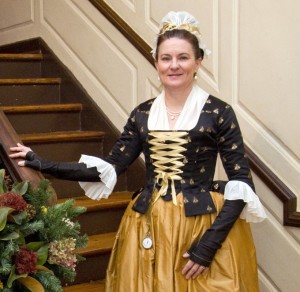 Relevant History welcomes Kimberly Walters, a living historian, author, and owner of K. Walters at the Sign of the Gray Horse, which offers historically-inspired jewelry. Kim is a proud horse mom first and foremost. She is a member of the National Society Daughters of the American Revolution, currently of the Fincastle Chapter of Louisville, Kentucky, as well as the Association of Living History, Farm, and Agricultural Museums. She also serves her country as a Federal employee. Sales from A Book of Cookery by a Lady help support her rescued Colonial Williamsburg horse. To learn more, check out her web site.
Relevant History welcomes Kimberly Walters, a living historian, author, and owner of K. Walters at the Sign of the Gray Horse, which offers historically-inspired jewelry. Kim is a proud horse mom first and foremost. She is a member of the National Society Daughters of the American Revolution, currently of the Fincastle Chapter of Louisville, Kentucky, as well as the Association of Living History, Farm, and Agricultural Museums. She also serves her country as a Federal employee. Sales from A Book of Cookery by a Lady help support her rescued Colonial Williamsburg horse. To learn more, check out her web site.
*****
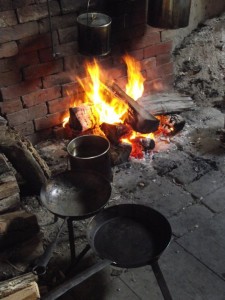 When I started participating in living history events, a friend recommended that I look into hearth cooking to give me a purpose and something to do. I was skeptical, but I am not one to sit around and do nothing, no matter where I am. Wasn’t that hot and sweaty work? With five rescue horses, I’m not a lightweight, so I am used to working hard, but this was a different kind of work. Nevertheless, I was not prepared for what I was getting myself into! I did start my research with passion and immersed myself into the subject. What’s not better to like than food?
When I started participating in living history events, a friend recommended that I look into hearth cooking to give me a purpose and something to do. I was skeptical, but I am not one to sit around and do nothing, no matter where I am. Wasn’t that hot and sweaty work? With five rescue horses, I’m not a lightweight, so I am used to working hard, but this was a different kind of work. Nevertheless, I was not prepared for what I was getting myself into! I did start my research with passion and immersed myself into the subject. What’s not better to like than food?
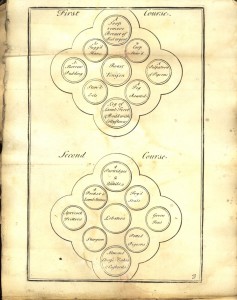 After I studied period cookery books and actually cooked over a fire, I compiled appropriate recipes (also known as receipts in the time period). I was so enamored with how they did things in the kitchen and in dining, I couldn’t stop. My original concept was to find the most common things of the time period that would assist me with interpreting this part of history to the public without a bunch of notes tucked away in my pocket (or having to remember it). It was all really meant for me. That sounds kind of selfish but it is true! However, many of us that do research cherish the little bits of information that we find that are not well known and like to keep them close to us like the “Gollum” did of the “One Ring” of the The Hobbit by J.R.R. Tolkien. They are precious!
After I studied period cookery books and actually cooked over a fire, I compiled appropriate recipes (also known as receipts in the time period). I was so enamored with how they did things in the kitchen and in dining, I couldn’t stop. My original concept was to find the most common things of the time period that would assist me with interpreting this part of history to the public without a bunch of notes tucked away in my pocket (or having to remember it). It was all really meant for me. That sounds kind of selfish but it is true! However, many of us that do research cherish the little bits of information that we find that are not well known and like to keep them close to us like the “Gollum” did of the “One Ring” of the The Hobbit by J.R.R. Tolkien. They are precious!
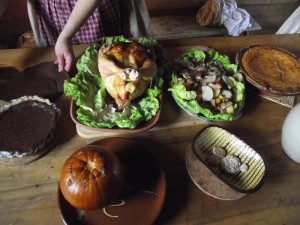 Five years later, I decided to publish my findings as A Book of Cookery by a Lady. I did so on what would have been my Mom’s birthday as a tribute to her. I was also enamored with an article written about Mrs. Elizabeth Thompson, George Washington’s housekeeper during the war years, by Ms. Nancy K. Loane. Mrs. Thompson’s service is not really well known, yet she deserves to be remembered for running the great general’s household and feeding his staff. I have compiled a history on her as a memorial of her service. It is a highlight of the book.
Five years later, I decided to publish my findings as A Book of Cookery by a Lady. I did so on what would have been my Mom’s birthday as a tribute to her. I was also enamored with an article written about Mrs. Elizabeth Thompson, George Washington’s housekeeper during the war years, by Ms. Nancy K. Loane. Mrs. Thompson’s service is not really well known, yet she deserves to be remembered for running the great general’s household and feeding his staff. I have compiled a history on her as a memorial of her service. It is a highlight of the book.
A lot of chapters are interesting from a historical viewpoint—but also very practical for today. This includes items in season, cooking terms, measurements, receipts, how to carve meats, setting a table for one to thirty dishes, and even how to choose your produce at the market.
Kitchen cleanliness and safety in the 18th century
One of the other areas that I think is highly important and underrepresented is cleanliness and safety in the 18th-century kitchen. What was really considered, done, and written down? I’m always asked if I am going to use bleach, soap, and sanitizer when cooking. No. I use 18th-century methods, and they work. General observations for cooks and what they needed to do to ensure they did not poison or make anyone sick were also noted in my book. This focused on utensils and equipment.
The types of metals that the equipment was made from and how they were cleaned was very important. If a cook wanted to poison someone, they could do so by using a certain type of pot that had verdigris on it and serving it right up! Cooks did not know that some of the metals were deadly that they used, but they at least knew that if they were not cleaned correctly, they could be deadly.
I caution the reader not to use an original pot or utensil to cook for demonstration or at home. We may not be able to identify the type of metal it is made from today. By focusing on M. Radcliffe, I highlighted this very issue. Radcliffe talks about lead and its hazards, which is somewhat unique, but by this time well known. Here is an excerpt from her book:
Lead is a metal easily corroded, especially by the warm steams of acids, such as vinegar, cider, lemon-juice, Rhenish wine, &c. and this solution, or salt of lead, is a slow and insidious, though certain poison. The glazing of all our common brown pottery ware is either lead or lead ore; if black, it is a lead ore, with a small proportion of manganese, which is a species of iron ore; if yellow, the glazing is lead ore, and appears yellowish by having some pipe or white clay under it. The colour of the common pottery ware is red, as the vessels are made of the same clay as common bricks. These vessels are so porous, that they are penetrated by all salts, acid or alkaline, and are unfit for retaining any saline substances. They are improper, though too often used, for preserving sour fruits or pickles. The glazing of such vessels is corroded by the vinegar: for, upon evaporating the liquor, a quantity of the salt of lead will be found at the bottom. A sure way of judging whether the vinegar or other acid have dissolved part of the glazing, is by their becoming vapid, or losing their sharpness, and acquiring a sweetish taste by standing in them for some time; in which case the contents must be thrown away as pernicious.
Source:
Radcliffe, M., A Modern System of Domestic Cookery: or, The Housekeeper’s Guide, Arranged on the Most Economical Plan for Private Families. Originally published in 1823, digitized on Google Books Aug 15, 2007.
*****
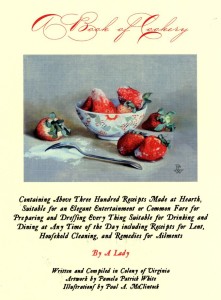 A big thanks to Kimberly Walters. She’ll give away a copy of A Book of Cookery by a Lady to someone who contributes a comment on my blog this week. I’ll choose the winner from among those who comment by Friday at 6 p.m. ET. Delivery is available within the U.S.
A big thanks to Kimberly Walters. She’ll give away a copy of A Book of Cookery by a Lady to someone who contributes a comment on my blog this week. I’ll choose the winner from among those who comment by Friday at 6 p.m. ET. Delivery is available within the U.S.
**********
Did you like what you read? Learn about downloads, discounts, and special offers from Relevant History authors and Suzanne Adair. Subscribe to Suzanne’s free newsletter.

Sounds interesting , its a pity its not available for delivery in the uk so therefore have.t commented
Hello Elisabeth Millard – my book is available for purchase on Amazon in the U.K. Check it out here:
http://www.amazon.co.uk/Book-Cookery-Containing-Receipts-Entertainment/dp/0692269800/ref=sr_1_1?s=books&ie=UTF8&qid=1442329720&sr=1-1&keywords=kimberly+k.+walters
I love old cookbooks. I really enjoy the ones that throw in history or just anecdotes and mussing’s from the author. I will be putting this book on my Christmas list to my husband. I am looking forward to reading your book.
Thank you so much Kim! I think you will really love it.
The one thing that will always be a passion of mine is recreating history through food. Nothing brings people together like a fine meal, snack or dessert. I look forward in reading! Excellent blog
I tried keeping my favorite recipes organized like this but didn’t have the patience for it! If I don’t win a free copy, I agree with the poster above that it will go on the Christmas List!
Thank you Sarah!
Hello Jennifer – my book includes a lot of receipts that would have been served at many a table in the time period. They are also very easy to make.
My family has a long history of cooking with fire on an open hearth so I’m thrilled to find there’s a considered effort on the part of the author to capture traditional cooking, and honoring her mother and General Washington’s cook in the process. Honoring ancestors and those who we call mentors is so important.
Thank you Tess! I also focus on my family history in doing genealogy, and feel that this type of research helps me to understand how they did things back in the day. Many cultures come into play in cooking, and that includes where they lived in the colonies as to what was available and how they did things. It is a very fascinating subject.
Some time back I became interested in the kind of food served to passengers and crew during long sea voyages. Three of the receipts I found were dandyfunk, made from bacon grease, breadcrumbs and molasses, plum duff and bergoo. Plum duff was basically rice and prunes, served frequently as dessert. I have not been able to pin down bergoo, but I believe it was some form of oatmeal served at breakfast.
Steve, that sounds awful. Don’t forget the limes. 😉
Hello Steve,
I do not focus on food for sailors – although there are beaten biscuits within my book. Now, I would definitely love it is you purchase my book as there are many techniques, etc., in there. But, there is another book out there if you can find it called “Lobscouse and Spotted Dog” which you may enjoy. There is a dish in there called, Boiled Baby. It is very very interesting.
Kim
What a great idea to put all this info from disparate sources into one book! You’ve done us all a huge service!
Thank you Eileen! I think you will love it.
Kimberly, you are quite the multitalented lady! I’ve always been a big fan of period/heirloom cookery (for those of us fortunate enough to be the recipients of family recipes & cookware, passed down through the generations) – I absolutely love that you’ve done this! (As an aside – I can’t tell you how many things I’ve had to discard from my fridge, because they’ve become “pernicious” – LOVE it!!)
Thank you for such lovely compliments Susan!
Kim
Historical cooking has long been an interest of mine. Sometimes recreating recipes (and other related knowledge) can be complicated by the steps and procedures not mentioned, probably because “everybody knows that.”
I love information like this! Nothing like making the past a little more real to us.
I will admit I was horrified during a tour of Old Sturbridge Village’s farmhouse at the numbers of flies on everything.
And I had to laugh as I just read an account of Lizzie Borden’s trial, where apparently it was reported that the family ate from the same lamb roast over the course of several days. Without refrigeration. Is it any wonder they got sick?
BTW, I’m a member of the Lydia Cobb-Quequechan Chapter of the Massachusetts DAR.
Hello Sheila! I cover the food so the flies do not get on it. A simple flour cloth works great. Some houses had places that kept food cool until it was needed and left overs was a staple for a cold dinner and sometimes at breakfast.
Glad to know you are a daughter!
Kim
I am interested in learning more. Very interesting topic. Thanks!
Great! If you do not win the book, you can purchase it directly from me, from Amazon or Barnes and Noble.
Kim
Wonderfully informative post. As a fellow author w/ a passion for the 18th-century I’d love this in my library & kitchen! Thanks for the chance!
You are welcome and if you do not win, it is available – just ask for it as a present! 😉
Excellent post and topic! I’ve done my fair share of open fire and fireplace cooking as a re-enactor and in the Society for Creative Anachronism, and keeping things clean and safe is a concern. I collect cookbooks, household manuals, etc. but most are either before or well after the 18th century. This book would certainly fill a gap in my collection!
Wonderful!
My gosh, this is fascinating. I love to watch the people at Williamsburg do their demonstrations, but never, ever thought to ask how things were cleaned back then. Congrats on publishing the book!
Thank you so very much! It was a pleasure to write.